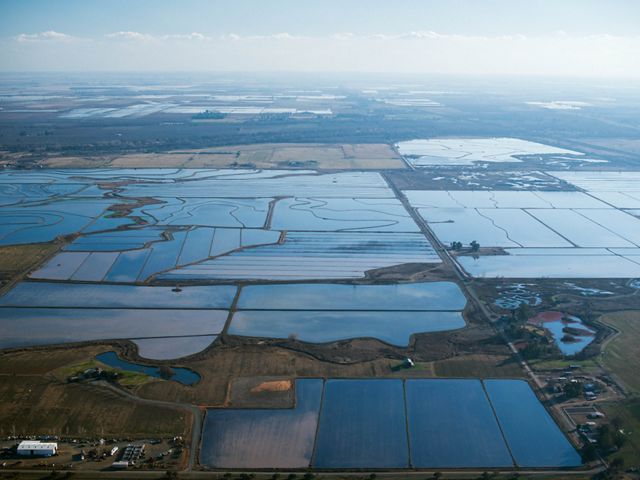Reclaiming Nature’s Value: Five Steps to Reforming Mainstream Finance
By Eric Hallstein, Economist & Senior Director, Sustainable Water Impact Fund
Key Takeaways
Nature is too often considered an economic "externality"—not priced or fully valued—and ignored on the balance sheet, usually at nature's and, eventually, society's expense.
We need to recreate our financial systems to ensure they value nature's benefits and lead to sustainable outcomes—and to do this, we need institutional investors such as insurance companies and banks on board.
As exemplified by a new TNC partnership, conservationists and institutional investors can collaborate to reform financial systems so that they better reflect the value of nature to the global economy.
Nature is often seen as something priceless, its worth beyond quantification. While there’s no doubt that nature has an intrinsic, non-economic value, it’s just as true that it is deeply intertwined with the global economy.
Earth’s natural systems provide vital clean air, water, food, fiber and other resources for an ever-increasing human population. And the connections go much deeper of course: climate change has exacerbated natural disasters like the recent mega-fires in Australia and the American West, tragically demonstrating how incredibly interconnected we are with the natural world, and how we suffer when we fail to take care of it.
Nature is too often considered an economic “externality”—not priced or fully valued—and ignored on the balance sheet, usually at nature’s and, eventually, society’s expense.

Does this mean that economic growth is doomed to undermine the natural systems that comprise our planetary life support system? Not necessarily. Responses to the COVID-19 pandemic have shown humanity’s capacity to rapidly change our behavior in order to mitigate an unimaginable threat. That offers hope that we can do the same with other challenges facing the planet.
But doing so will require us to recreate our financial systems so that they value nature’s benefits and lead to long-term sustainable outcomes for people and nature. And we must do so at a pace and scale commensurate with massive global environmental problems like water scarcity and climate change.
Quote
Nature is too often ignored on the balance sheet—usually at nature’s and, eventually, society’s expense.
Institutional investors are part of the solution
While the growth of environmental, social and governance (ESG) funds and impact investing in recent years has unlocked new sources of private finance that supports the natural world, it’s still not enough. We need institional investors—large organizations like insurance companies and banks—on board if we want large-scale reformation of financial services.
Institutional investors collectively oversee the bulk of some US$88 trillion of global assets under management. That is a staggering amount of money and underutilized potential to address environmental sustainability challenges at unprecedented scales and speeds—global philanthropic funding for the environment is a drop in the bucket by comparison.

Environmental organizations can be change agents
But this type of capital alone is not sufficient to create meaningful change. The transformation of the mainstream financial markets needs to be deep and durable, and measured against rigorous scientific goals. In this needed transformation, environmental nonprofits have much value to share with institutional investors. TNC has for decades sought to leverage its scientific expertise to influence the private sector to improve practices at large corporations such as Syngenta and Dow Chemical. And TNC has used its environmental and financial expertise to create new models for significantly improving conservation, including through impact investing.
Based on these experiences, we identify five foundational elements required for effective collaborations between conservationists and institutional investors.
1. Lead with science and evidence. Science- and evidence-based decision-making are core tenets of the world’s leading environmental nonprofit organizations. This kind of decision-making can be used to rigorously quantify the value of nature’s resources, and contribute to models that better predict the needs of people and nature. Furthermore, nonprofits are often at the leading frontiers of new forms of data collection and analysis, such as remote sensing imagery, citizen science and machine learning—all of which can validate and provide fresh insights into environmental impacts and risks and inform new business and investment opportunities. TNC’s novel BirdReturns program, for example, relied on one of the world’s largest citizen databases as well as tremendous computing power. Given the heavy reliance of the investment sector on data-driven approaches—albeit with different goals, incentives and tools—there should be fertile ground for collaboration between institutional investors and conservationists.
2. Make the investment case. A key indicator of progress is the extent to which institutional investors incorporate environmental impacts and risks into their decisions. The letter sent by BlackRock—the world’s largest asset manager—to its clients announcing it would make environmental sustainability integral to investment portfolio construction and risk management as well as BlackRock’s more recent partnership with Rhodium Group to assess climate-related risks to specific asset classes are examples of the change we need across the entire financial services industry. Since institutional investors have a fiduciary obligation to maximize profit, it is imperative that we demonstrate how environmental impact can be achieved without compromising investor returns. If we ask investors to trade off financial returns for doing good, we will not be able to mobilize mainstream investors who must fulfill their fiduciary duties to clients.
Our global insights, straight to your inbox
Get our latest research, insights and solutions to today’s sustainability challenges.
Sign Up3. Aim high. There is a risk in not being ambitious enough. The most recent report from the Intergovernmental Panel on Climate Change says that humans have about a decade to address the climate crisis. This is a critical decade for a host of other environmental issues too. Business-as-usual is not getting the job done. The mega-fires, extreme droughts, and massive storms that have historically been treated as black swan events are the new normal. That means our current approaches and models are underestimating environment-related risk. We need to be working at immense scale, innovating rapidly and taking appropriately considered but significant risk when the potential benefits justify it.
4. Build deep trust. Investors and conservationists have different ways of making decisions, methodologies, values, and organizational cultures. These differences can be significant barriers to collaboration and overcoming them requires building deep trust to ultimately achieve true partnership. Building trust requires taking the time to forge relationships, to recognize each other’s strengths that are essential to the partnership, to rigorously evaluate the differences in and rationale for each others’ analytical approaches, and to create a common language for describing benefits and risks. Trust and true partnership do not require agreement on all issues. They must, however, be based on a commitment to work across cultures and knowledge bases to create innovative, often multi-disciplinary, solutions to challenging problems. It is equally important to build investors’ trust in the efficacy of the product—this requires rigorous monitoring and evaluation protocols, which will allow the partners to ensure results are above the industry’s average.
5. Keep working on policy and other conservation strategies. Markets do not exist in a vacuum, nor are they the answer to every problem. Environmental organizations should be working to understand and strengthen the policy and legal frameworks that influence how environmental markets operate and address market failures. At the same time, institutional investors should share how various policies impact their decision-making and create or remove barriers. More communication between entities that see different sides of the same issue will be key for coming up with effective solutions.

Case Study: A Partnership for Sustainable Food and Water
Nearly three-quarters of all irrigated land globally is at risk of lost production due to water scarcity—this crisis threatens some 4 billion people every year.
Environmental organizations like The Nature Conservancy (TNC) are addressing the global water crisis through multiple strategies that span policy, market design, direct management on working lands, land restoration, and long-term protection. Yet the magnitude and intractability of this challenge mean that it’s urgent we pick up the pace and scale. Given the size of the global financial markets and their impact on nature, institutional investors have to be part of the solution.
Take California as an example. California has one of the largest, most engineered water infrastructure systems in the world, supporting an agricultural economy that is one of the world’s most productive and profitable. But this system is ecologically and financially unsustainable. Approximately half of all freshwater species in the state are at risk of extinction and 90 percent of all endemic species are threatened. Aging or non-existent infrastructure for storing and transporting water, population growth and urbanization, pollution of surface and groundwater, and increases in climate-driven variability in the timing and volumes of precipitation are subjecting the state’s agricultural industries to unprecedented levels of stress.

Recently, TNC launched an ambitious partnership with RRG Capital Management LLC (RRG), a Los Angeles based investment firm supported by a team with two decades of experience in sustainable, innovative water management and agriculture development globally. RRG and TNC collaborated to co-design a conservation framework for an institutional-scale vehicle that would invest in land and water assets to improve the management of surface water, groundwater and farms with a focus on California, Australia and Chile to more sustainably manage water resources, the environment and the agricultural economy, while at the same time fulfilling its fiduciary responsibilities to investors. TNC is a technical advisor to the fund, helping to increase sustainability benefits and support target species and ecosystems on land and in the water. The goal is to invest in and operate assets that can achieve market returns and set new standards for environmental leadership and social responsibility.
Success will demonstrate that it is possible—and indeed profitable—to invest and operate agricultural assets that sustain the economic livelihoods of farmers and the communities who depend on a vibrant agricultural sector, while at the same time protecting farmland, and achieving very real conservation benefits like building seasonal wetlands, and making water available in streams at critical times for wildlife. Innovative practices developed through this partnership may be replicated across California and other water-scarce regions of the world.
The critical decade
We are in a critical decade for the environment. We need action now—and we need new sources of capital to fund that action. By using the deep scientific expertise of environmental organizations, we can influence the mainstream investment sector to value nature. Doing so will make that sector work better for all of humanity, and for the planet on which we rely.
Global Insights
Check out our latest thinking and real-world solutions to some of the most complex challenges facing people and the planet today.



